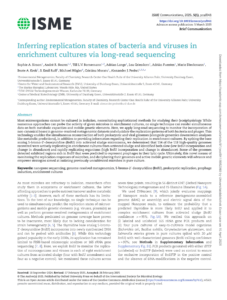In March 2025, a new publication by Sophie Simon, Prof. Dr. Alexander Probst (University of Duisburg-Essen) and Dr. Michael Hügler (TZW) appeared in the journal ISME Communications, presenting a new metagenomic method for determining the activity of microorganisms in environmental samples.
Metagenomics has been used for several years to investigate the diversity and metabolic potential of microbial communities, i.e. which microorganisms are present and which metabolic pathways they are capable of. Until now, however, metagenomics has not been able to identify which of these microorganisms were active at the time of sampling.
In the current study, the researchers show that nanopore-based metagenomics can also provide information on the replication activity of microorganisms. For this purpose, BrdU (a thymidine-like base analog) was added to enrichment cultures, which is incorporated into the DNA of actively replicating prokaryotes. With the help of bioinformatic analysis, this signal can then be recognized in the sequencing data.
Initially, the method was successfully tested on pure cultures. In a next step, the researchers were also able to specifically detect active microorganisms in more complex enrichment cultures from activated sludge. Surprisingly, some phages in the lytic cycle also showed a strong BrdU signal.
This study marks a first important step towards activity-based metagenomics. It shows that modern sequencing technologies are fundamentally suitable for drawing conclusions about microbial activity. Further methodological developments are still required to be able to apply such approaches directly in situ in future, i.e. without enrichment in the laboratory.
Publication: https://academic.oup.com/ismecommun/article/5/1/ycaf041/8052969


